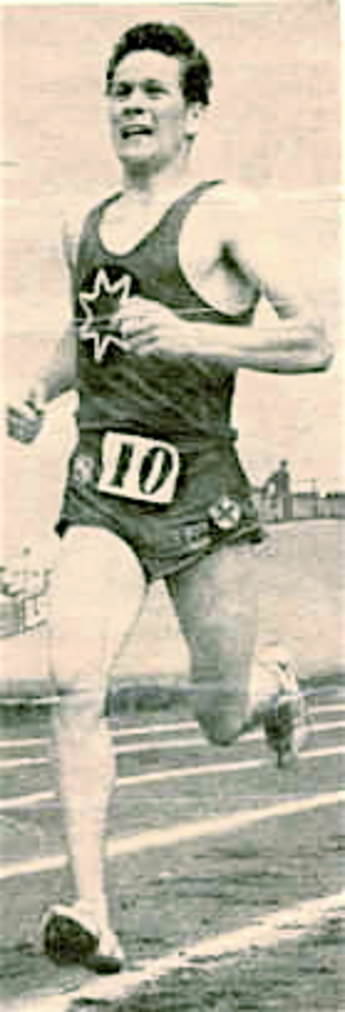
Profile: Alan Simpsonb. 1940 Alan Simpson was one of the most successful 1,500 runners during the 1960s. In his prime this fierce competitor rarely lost a race. He had an amazingly successful record in the two-a-side international competitions that were very popular at that time, winning 14 of his 17 races for his country. He set British records for 1,500, the Mile and 2,000, won the Mile British title three consecutive years (1963-65), and represented England in the International Cross-Country Championships. His best performance in major competitions was fourth in the 1964 Olympic 1,500; as well, though neither performance pleased him, he won a silver medal at the 1966 Commonwealth Games and placed fourth in the 1966 European 1,500.
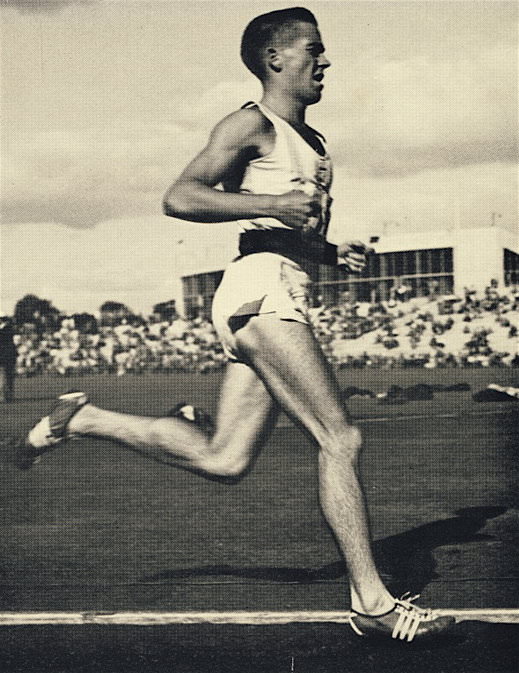
Albie Thomas: Profile 1935-2013When 21-year-old Albie Thomas of Australia burst on to the international scene with a fifth place in the 1956 Olympic 5,000, coach Percy Cerutty considered him the “best runner, technically speaking, in the world today.” (Middle-Distance Running, pp.49-50) Eighteen months later, Thomas fulfilled the great promise Cerutty had seen in him with an amazing 59 days of racing on the European circuit, during which he won nine of 16 races. In these races he not only broke two world records (Two Miles and Three Miles) but also won two Commonwealth Games medals, broke the Australian 3,000 record, ran a 4-minute mile, paced Herb Elliott to both his Mile and 1,500 world records and won the Three Miles in the British Games.
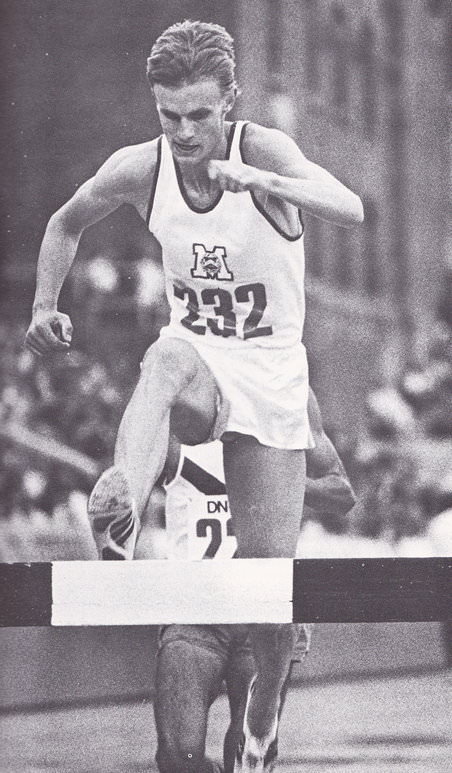
Anders Gärderud Profileb. Aug. 28, 19466’1” (1.86 m) 154 lbs (70 kg) The story of Anders Gärderud is a story of promise fulfilled. It’s also a story of setbacks and of the need for a radical reassessment of a running career. Gärderud has been Sweden’s greatest runner since Andersson and Hägg. Thirty years after these two great runners had rewritten the record book for 1,500 and the Mile, he broke the world Steeplechase record four times over a four-year period, reducing it an amazing 12.6 seconds. And he capped off his career in the best way possible with an Olympic gold medal in a world-record time.
PROFILE: ARNE ANDERSSON1917-2009b. Trollhätten, Sweden. 70kg/154lbs 5’10”/1.78 It was a great honour for the 21-year-old Arne Andersson to represent Sweden in the 1939 Finnmark competition against Finland. For his international debut, he had been chosen as the second string to Åke Jansson in the 1,500 after improving his 1938 PB by five seconds with 3:53.8. His role in the four-man race was to help Jansson win by pacing him until the final stages. Jansson, with a 3:52.4 PB, was expected to need help as his two Finnish adversaries, Hartikka and Sarkama, were also 3:52 runners.
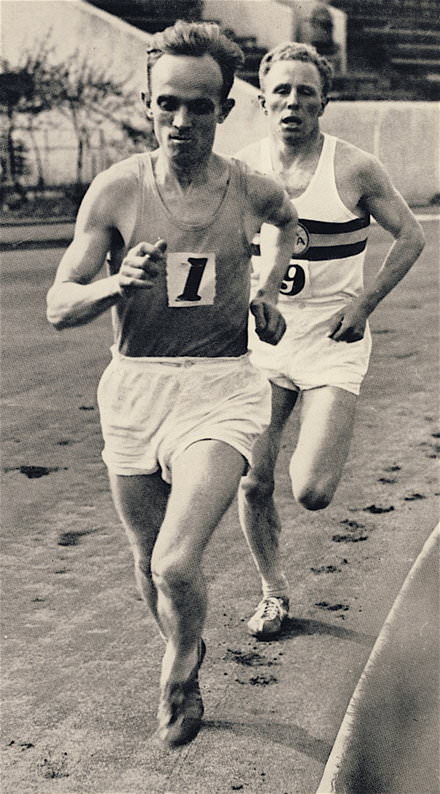
PROFILE: BASIL HEATLEY 1933-2019 From 1948 through to the 1960s, English runner Basil Heatley improved steadily, winning countless titles on the road, track and country. Among his most notable achievements were a World-Record 10 Miles, an International Cross-Country title and three National Cross-Country titles. As he approached retirement, the one achievement he lacked was participation in a major games. He had come close, narrowly missing selection for the 1958 Empire Games and for the 1960 Olympics, and then being injured during the build-up to the 1962 Empire and European games.
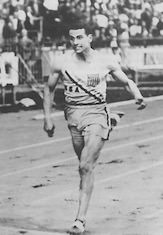
With his talents, American miler Bill Bonthron could have conquered the world. He had strength, speed and a tenacious competitive drive. But while he performed brilliantly in his own country and even set a world record for 1,500 in 1934, he made little impact on the international scene and never competed in an Olympic Games. Following the traditional amateur conventions of his time, Bonthron planned his athletic career for just the four years of his university education. Once he graduated and married, his priority was his job as an accountant and he announced his retirement from running in 1934. Although he later broke with convention and continued to train seriously in his spare time, he never regained the form of his university years and failed to qualify for the 1936 Berlin Olympics. He did make one European tour in his graduating year, but failed to live up to the reputation that had crossed the Atlantic before his arrival.
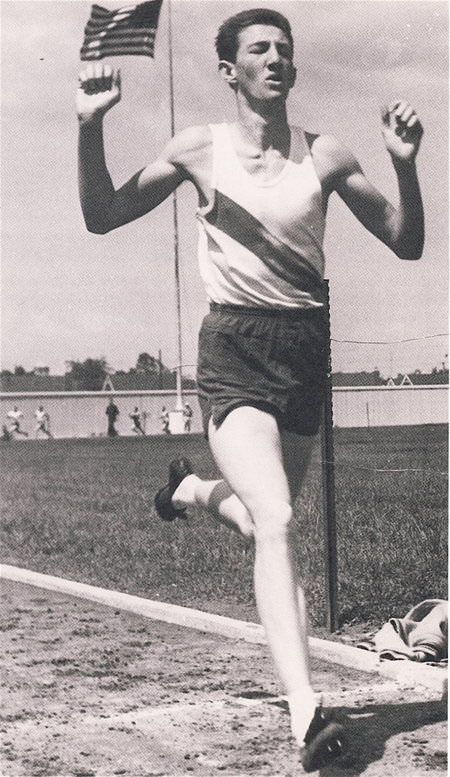
Bob Schul: Profile b. 1938 American Bob Schul is best known for his stylish and confident win in the 1964 Olympic 5,000 in Tokyo. He also ran one WR (Two Miles), set five American records and won three American titles. His achievements are all the more remarkable because he suffered throughout his career from severe allergies and ensuing asthma. Schul’s success as a runner is testimony to his determination and competitive spirit. Early DaysMany great distance runners have a history of hard physical work in childhood, and Schul is no exception. The second of four brothers, he grew up on an Ohio farm, where he was inevitably given chores involving physical work. “When you live on a farm,” he says, ‘there is work to be done, and you do it as there are no excuses…. The consistent, hard work of a farmer is similar to the consistent effort necessary to be a great athlete.” (Bob Schul Interview: garycohenrunning .com) One of his jobs was bringing in the cows from the pasture: “So after school I began a long trek across the road and down to the pasture…. During hot days, the cows would go deeper into the woods where it was cooler…. To get the job done more quickly, I began running to find them.” (Schul, In the Long Run, p.16) But his childhood was far from perfect because he suffered badly from allergies, almost dying from an attack at 15 months. Nevertheless, Schul participated in team sports and made his high-school basketball and football teams. And he showed good endurance in cross-country and the Mile. He ran 5:10 in his freshman year, 4:50 the next year, and 4:34 for his last two years in high school.
Bodo Tümmler Profileb. December 8, 1943 In 1965 West German Bodo Tümmler burst dramatically on to the 1,500 European scene that had been dominated by Michel Jazy, Siegfried Valentin and Witold Baran. His European Cup victory and his fast 3:39.5 clocking at the age of 21 promised great things. The next year he won the European 1,500 title from 30-year-old Michel Jazy and placed a close third in the 800. Demonstrating not only great tactical skills but also strength and speed, the Berliner was being hailed as Europe’s Peter Snell. And although he was slowed somewhat by injuries the next year, his 1968 pre-Olympic form was impressive. And he did well in the high altitude of Mexico City, coming third in the 1,500 behind two great performers in Keino and Ryun. Sadly his career deteriorated after this as he battled with injuries. He never quite regained the form of his glory years between 1965 and 1968. But in those few years he was among the best in the world.
BRIAN HEWSON: PROFILE1933 - 2022 This highly talented English runner emerged in the early 1950s as a world-class 880-Mile runner. Throughout his running career, which ended in 1960, he worked full-time. Nevertheless, he won 17 national titles, a European title and two silver Empire Games medals. He was also one the earliest four-minute milers. Beyond his undeniable athletic gifts, Hewson showed an early maturity that enabled him to dedicate himself to running while developing a career in tailoring.
Bruce Tulloh Profile 1935-20185’7”/1.71; 119lbs/54kg Bruce Tulloh became a world-class runner in the 1960s, despite having limited natural talent. When in 1955 he returned home to England from his military service in Hong Kong, he was little more than an also-ran, someone endearingly called a scrubber in British running clubs. As a 20-year-old he had barely beaten 16:00 for Three Miles (16:30 for 5,000), and his only claim to fame was a Hong Kong Three Miles title. True, he did really enjoy running, but there was no indication that within four years he would be the British Three Miles Champion and that within seven years the European 5,000 champion.